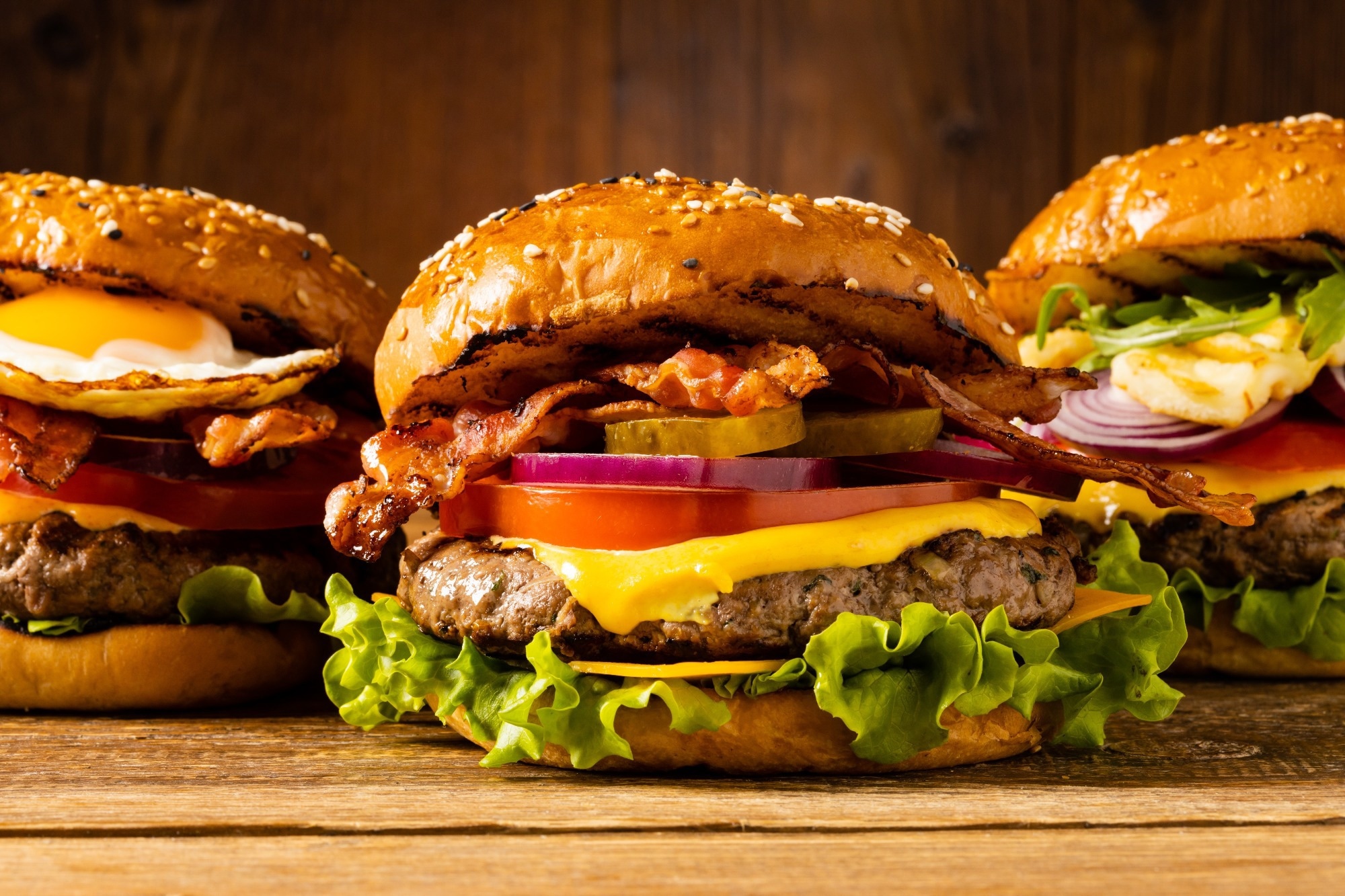In a recent study published in the Food Research International Journal, researchers reviewed the differences in the digestive process between beef- (BB) and plant-based burgers (PB), from ingestion to excretion.
 Study: The digestive fate of beef versus plant-based burgers from bolus to stool. Image Credit: gkrphoto/Shutterstock.com
Study: The digestive fate of beef versus plant-based burgers from bolus to stool. Image Credit: gkrphoto/Shutterstock.com
Background
Ultra-processed PB and traditional BB share similar organoleptic characteristics, yet a knowledge gap exists in understanding how consumption of the different physical structures alters lipemic response and the gut microbiome.
Comminuting muscle results in the disruption of fibrillar muscle tissues, which leads to the presence of partially intact meat fibers and their bundles being randomly distributed in comminuted-BB.
A high shear process breaks down muscle cell membranes, which helps in salt infusion to extract myofibrillar proteins. This results in the formation of a three-dimensional protein network upon cooking.
The appeal of plant-based meat analogs has increased due to consumer concerns about greenhouse gas emissions, animal welfare, and the resources required for food production. These analogs come in various forms, such as patties, sausages, and nuggets have similar sensory characteristics to meat.
About the study
In the present study, researchers analyzed the structural variations between BB and PB burgers throughout digestion using the TIM Gastrointestinal Model.
BB and PB were acquired for analysis purposes. The moisture, protein, lipid, and ash content were analyzed. The free fatty acid (FFA) composition of extracted crude oils was analyzed by converting triglycerides into fatty acid methyl esters (FAMEs) through methoxylation.
The TIM-1 model simulates digestion for BB and PB with the lipid fed-state protocol. The TIM-1 model accurately replicates human small intestinal and gastric conditions, with a strong correlation between in vitro and in vivo outcomes due to its precise pre-determined parameters.
TIM-1 experiments were conducted to analyze the microstructure of digesta obtained at various intervals during simulated digestion occurring in the gastric, ileal, and jejunal compartments. Nuclear magnetic resonance was used to quantify branched-chain fatty acids (BCFAs) and short-chain fatty acids (SCFAs).
Results
The moisture, protein, fat, ash, and carbohydrate compensation varies remarkably between BB and PB burgers. BB contains higher amounts of protein and fats compared to PB. On the other hand, PB has higher carbohydrate levels due to adding potato starch, methylcellulose, and maltodextrin, which are necessary for creating a meat-like texture in the product.
The proximate analysis revealed that the crude oil generated from Soxhlet extraction had both unsaturated and saturated FAs in BB, while PB mainly contained unsaturated FAs due to the canola oil used in its formulation.
Bacteroidetes, Proteobacteria, and Firmicutes contributed the most abundant sequences. The Firmicutes proportion after stabilization is similar to the initial fecal specimen’s microbial content. After a seven-day treatment with PB or BB, there were notable differences in the abundance of Firmicutes and Bacteroidetes in the ascending colon (AC) and transverse colon (TC).
Bacteroidetes were higher after BB, while Firmicutes were higher after PB intake. This indicated a significant variation in bacterial colonization, as noted by the higher Firmicutes to Bacteroidetes ratio (F/B ratio) after PB intake for seven days.
Studies have reported a higher F/B ratio in obese persons, but the Firmicutes proportions differed among the fecal microbiome of healthy subjects. The relationship between health status and the F/B ratio is becoming unclear as more studies are conducted. Obesity may be linked to various fecal microbiota profiles.
The Simulated Human Intestinal Microbial Ecosystem (SHIME) colon vessels were found to be dominated by 25 bacterial genera and 17 bacterial families. The analysis also revealed that four families and eight genera showed significant differences in abundance between PB and BB treatments.
Specifically, four taxa were found to be characteristic of PB, while seven were associated with BB. Consuming PB led to a notable increase in the prevalence of Enterobacteriaceae, Clostridiaceae, and Planococcaceae sp. Lysinibacillus was found exclusively in the AC, while AC and combined vessels also contain other microorganisms.
The presence of protein in the gut environment may lead to the growth of proteolytic bacteria, such as Clostridiaceae, despite the potential suppression caused by carbohydrates. Citrobacter is more abundant in PB at T7 in the AC and TC. This could pose a potential risk for gastrointestinal disorders with long-term intake of meat analogs.
On day seven of treatment, BB led to a remarkable increase in butyrate, propionate, and acetate levels, while PB elevated butyrate levels and reduced propionate and acetate production. BB has a higher total SCFA concentration than PB in the TC. BB displayed a higher concentration of butyrate than PB towards the treatment’s end.
During BB therapy in the AC, certain bacteria that produce SCFAs were identified. These include Megasphaera, which produces butyrate, and Alistipes, Blautia, and Bacteroides, which produce acetate and propionate. These bacteria can work together through metabolic cross-feeding to improve microbial productivity and stability.
Conclusion
The study findings showed that plant- and animal-based meats have different digestive fates from ingestion to excretion. After consuming BB and PB, there were several variations in gut microbial population and metabolites.
This suggests that the nutritional content and nutrient efficiency affect substrate usage and bacterial proliferation, which leads to changes in metabolite production.
Researchers believe that meat substitutes need to replicate the sensory characteristics of real meat, and future advancements should focus on creating structures similar to whole foods.

